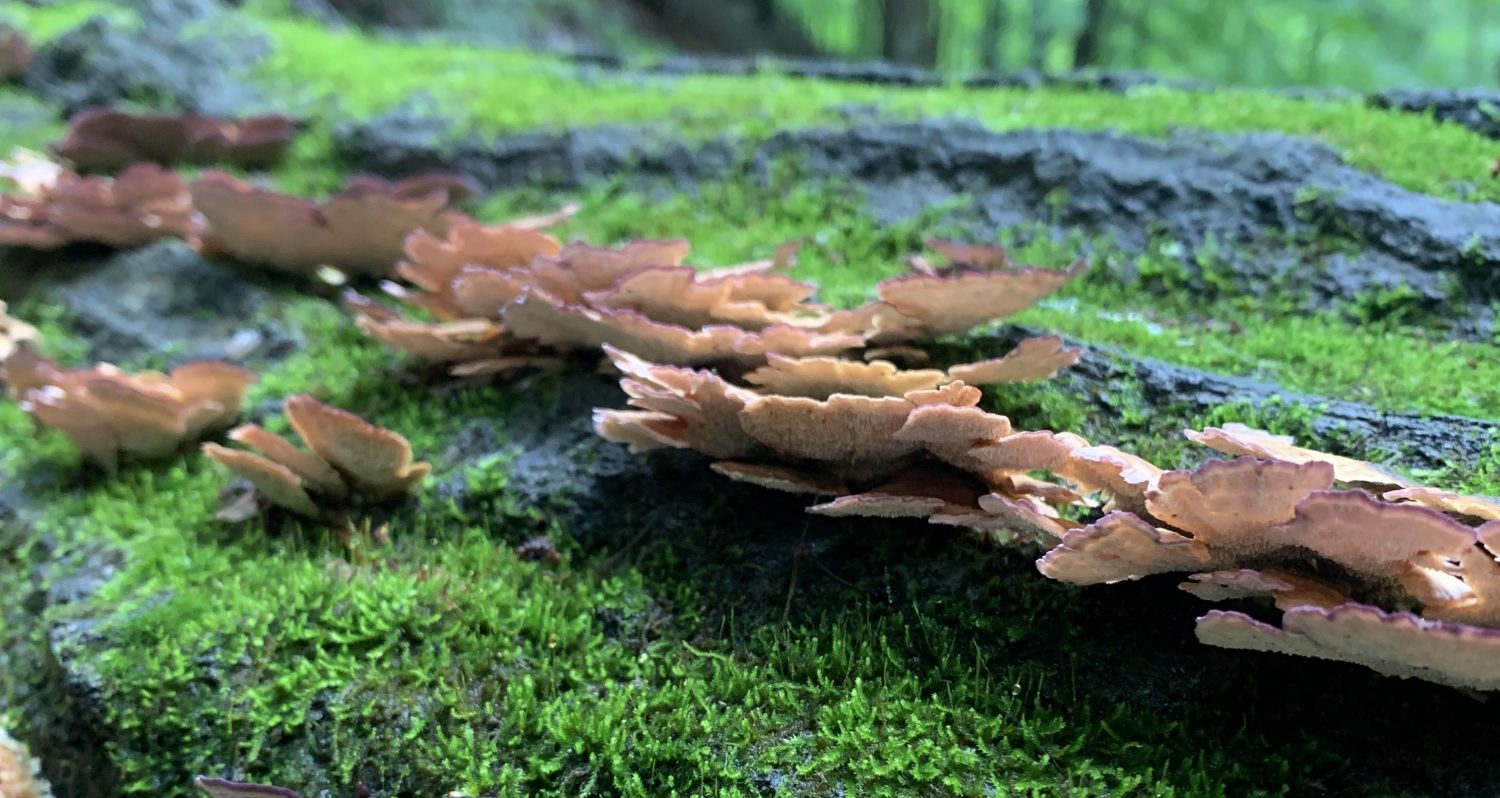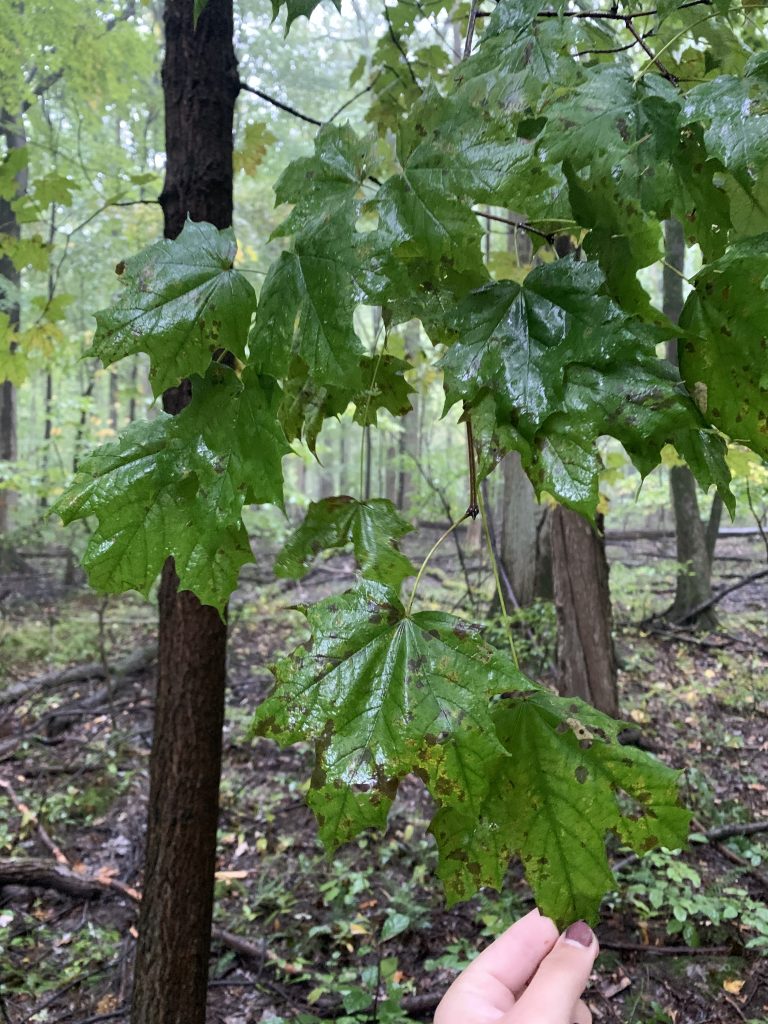Botanical Survey!
Emily Traphagen Park Botanical Survey
My survey site is Emily Traphagen Park, a part of the Preservation Parks of Delaware County. Tucked away on a well hidden road (literally, the road it’s on is called Seldom Seen Rd), Emily Traphagen Park is truly one a hidden treasure. This park houses several unique ecosystems, containing woodland, prairie, wetland, and a meadow, and hosted a wide range of wonderful plants and biodiversity.
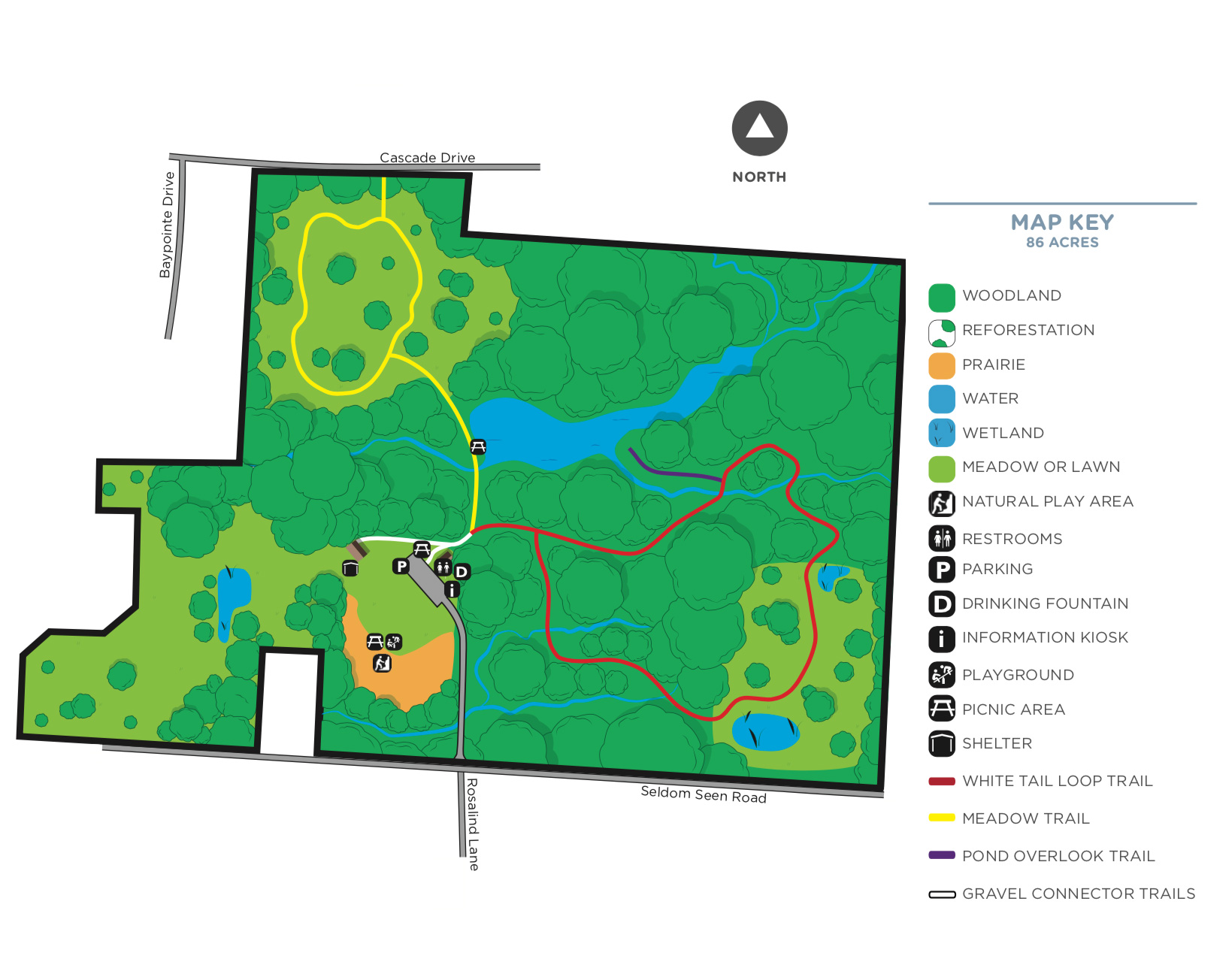
From: https://preservationparks.com/parks/emily-traphagen/
While I’m toootally only there for the plants, this park was a wonderful site for some birding, too. As I was investigating my first flowering species, I heard the tentative knocking of a young Northern Flicker learning how to be a good woodpecker and ended up encountering 5 Flickers all hanging out together on a dead tree. What a wonderful welcome to my study site!
So, that finally brings me to my first Botanical Survey:
Flowering & Fruiting Guys
Northern Spicebush, Lindera benzoin
With striking red oblong drupes, Northern Spicebush is easy to spot. In addition to looking striking, this particular species has something special. If you grab a fruit or leaf and give it a good ol’ scratch and sniff, you can smell the wonderful, spicy scent for which the plant gets its name. I think it smells absolutely wonderful and I want it as a candle.
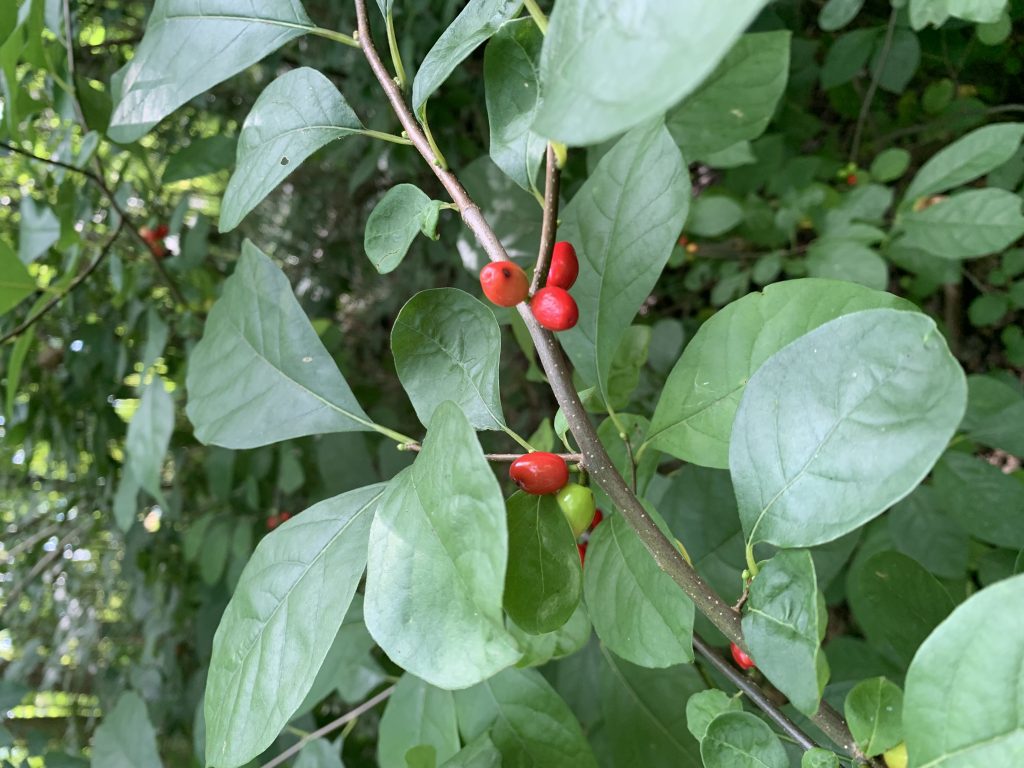
Ripe fruits of the Spicebush
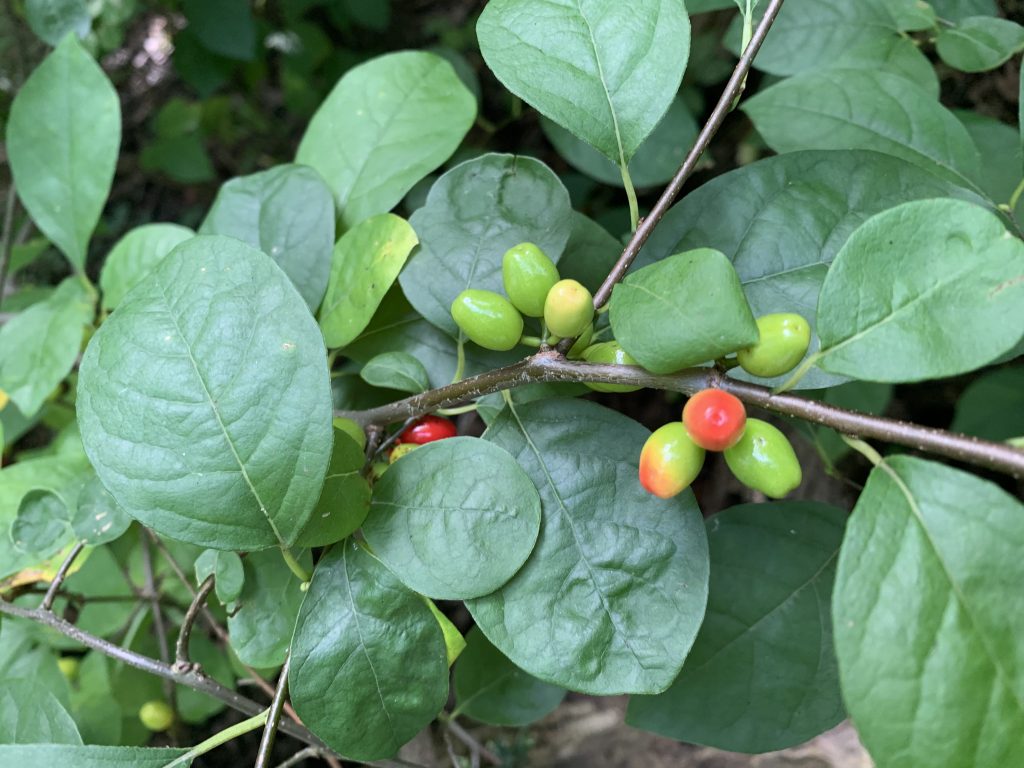
Unripe fruits of the Spicebush
Spicebush is an important host plant species for the Spicebush Swallowtail, Papilio troilus, which is dependent on spicebush as a food source.
https://entnemdept.ufl.edu/creatures/bfly/spicebush_swallowtail.htm
Red Cover, Trifolium pratense
This is a very common flower found from spring to fall in Ohio.
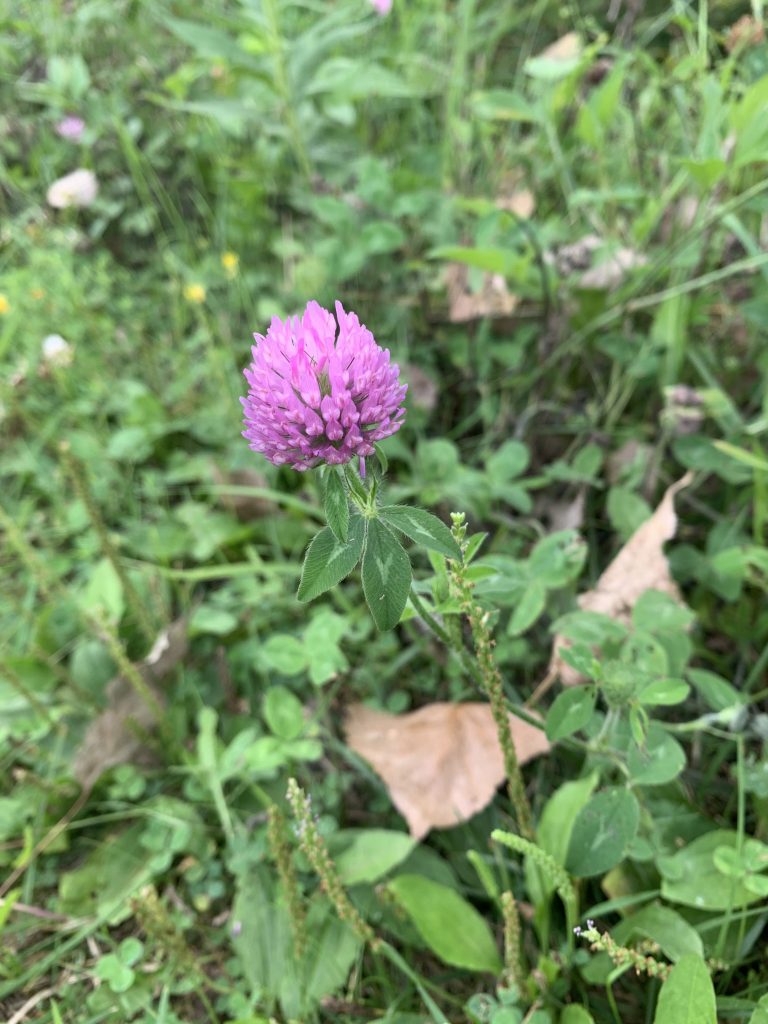
According to the American Botanical Council, Red Cover had myriad uses in Indigenous cultures, like treating sore eyes, burns, coughs, fevers, and, most notably, mesopause (disappointingly, they did not credit any specific peoples).
New Trees!
Honey Locust, Gleditsia triacanthos
Identifiable by its compound pinnate leaves and awesome thorns (I poked them, I just had to, and they’re pretty sharp), this is the Honey Locust.

Sharp thorns!!
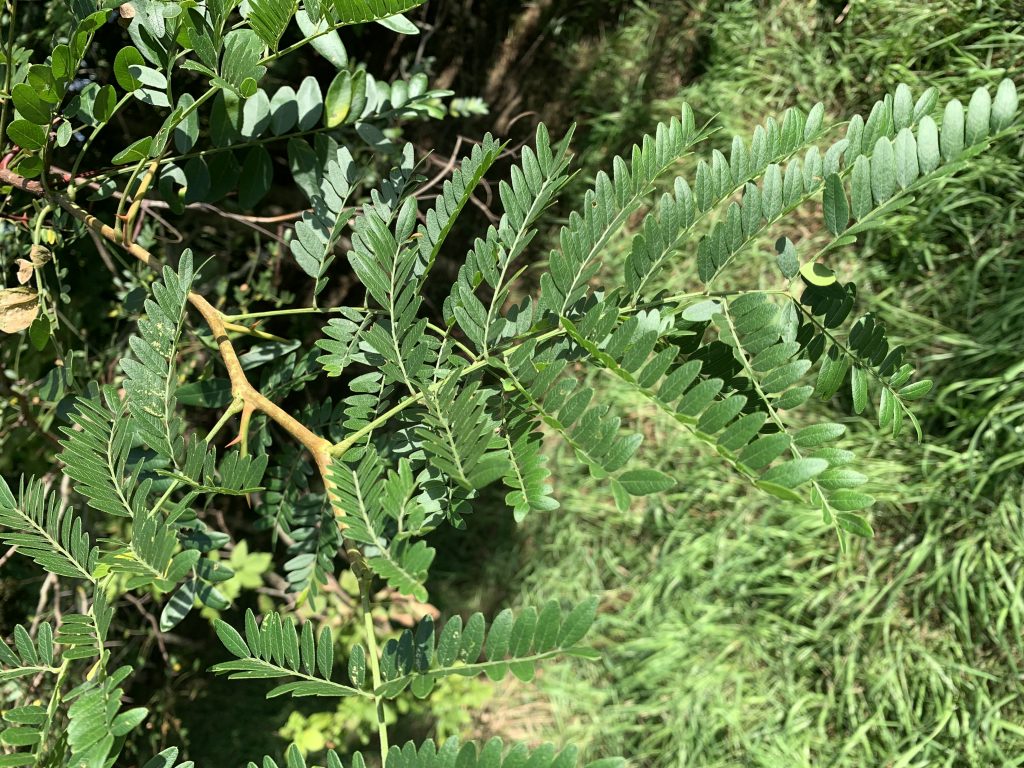
The Cherokee had many uses for the Honey Locust. The raw, ripe pods were eaten, infused in drinks, and were used to sweeten bitter medicines. More importantly, Honey Locust pods were used as a treatment for indigestion and for whooping cough.
Honey-locust – Gleditsia triacanthos
Green Ash, Fraxinus pennsylvanica
Green Ash is identifiable as a member of the Ashes by its opposite, pinnate leaves and flattened twig arrangements.
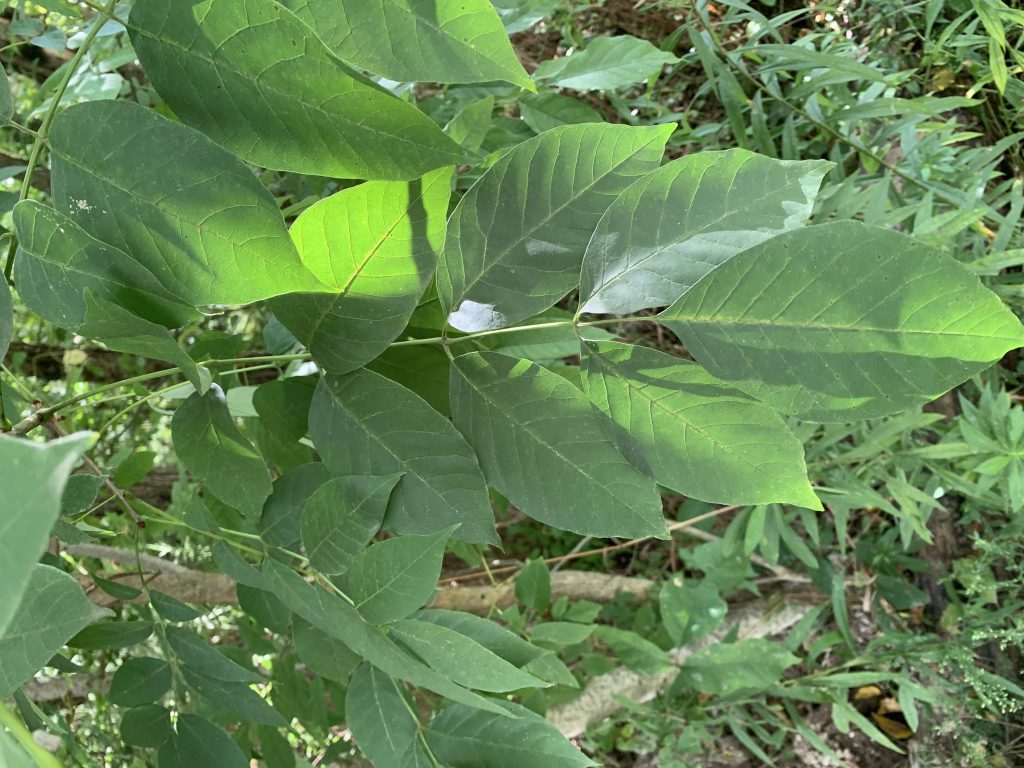
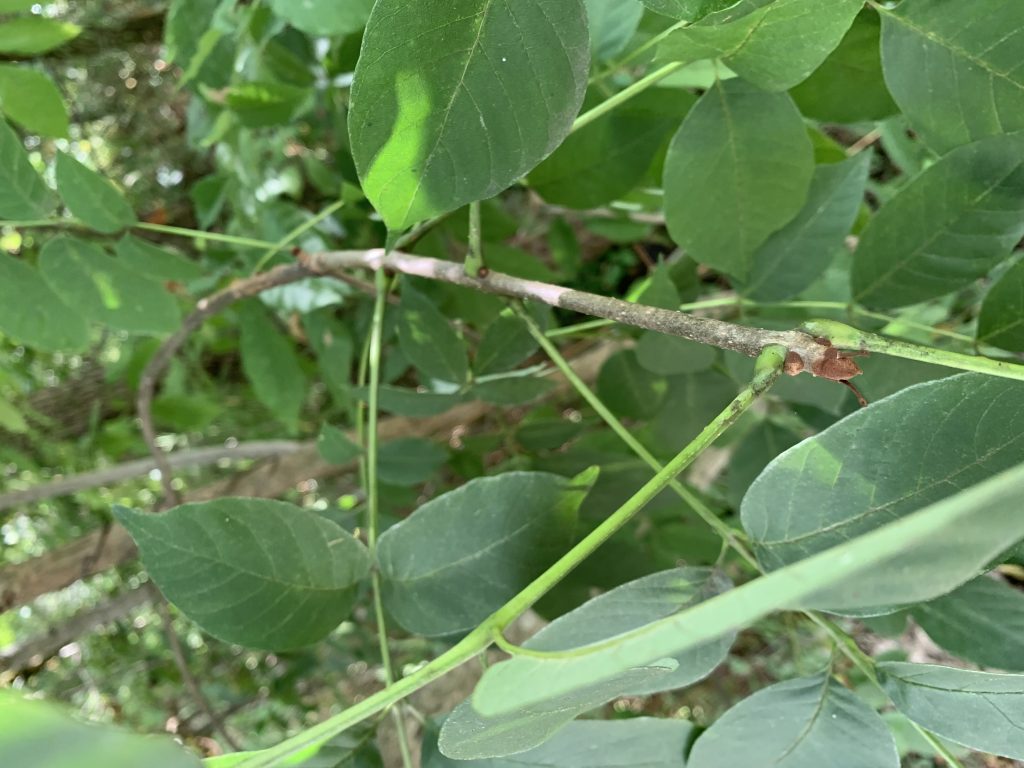
Shrubby Shrubs & Woody Vines
Prickly Dewberry, Rubus flagellaris
Prickly Dewberry is a flattened shrub that acts like a woody vine. With its leaflets of 3-5 and round stem decorated with prickly thorns, I was able to identify it using my Peterson Guide.
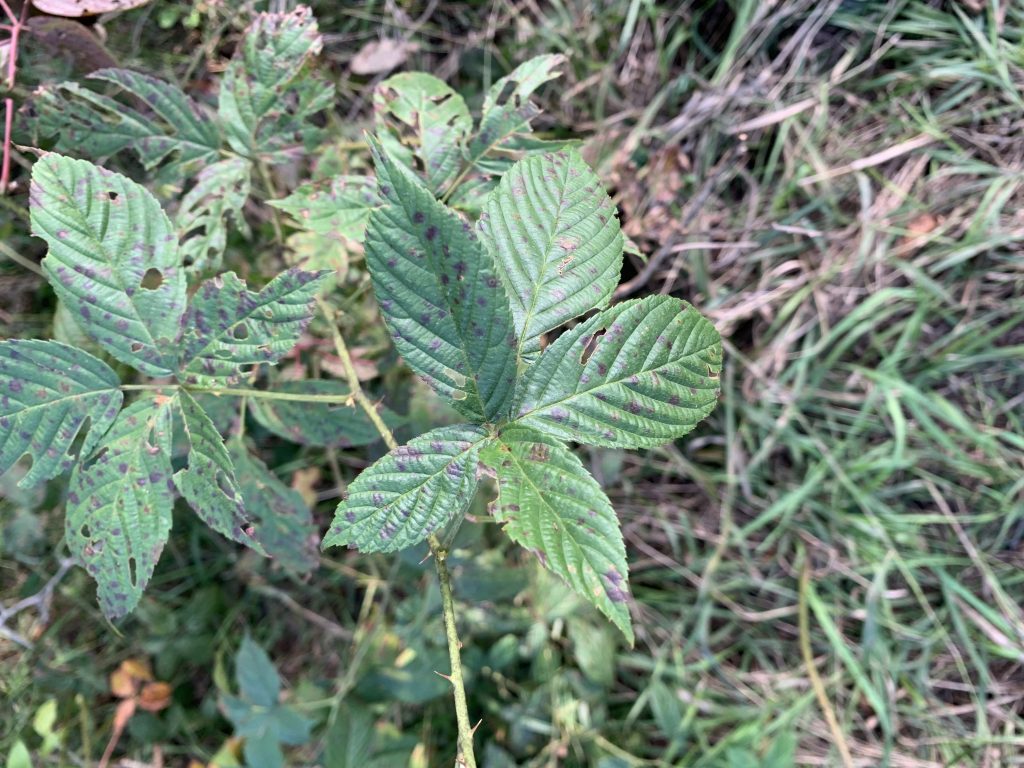
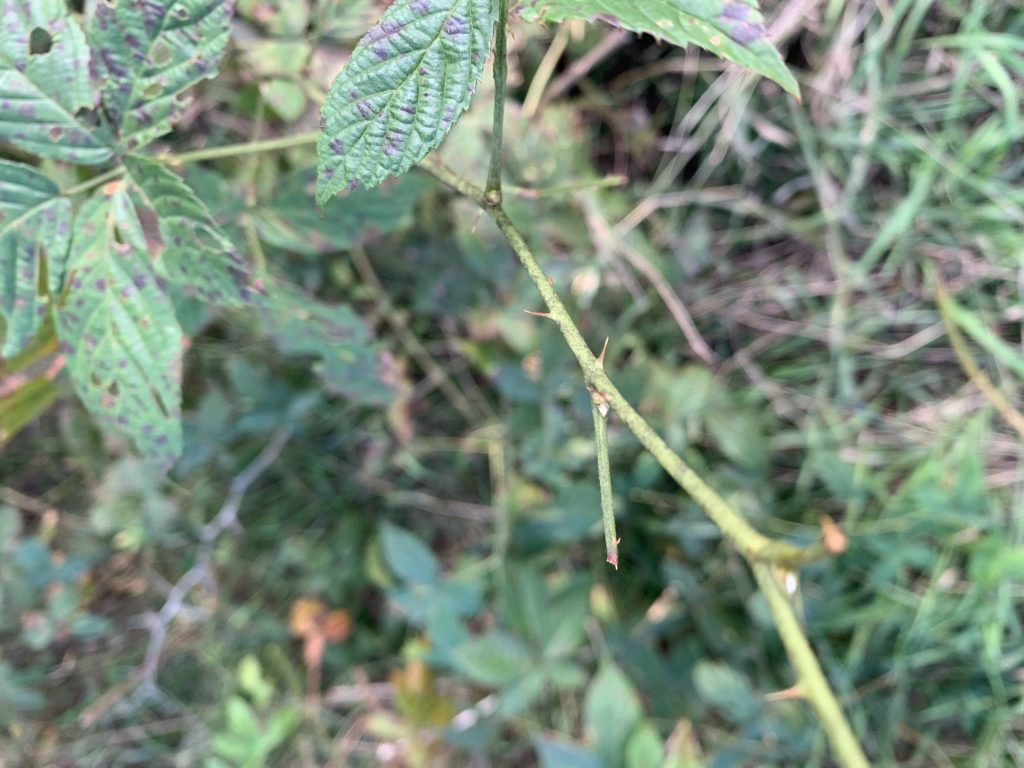
Black Raspberry, Rubus occidentalis
This is an arching shrub with leaves that are white underneath similar to the Red Raspberry, however the Black raspberry has palmately arranged leaves of 3-7.
Currently, lots of interesting research is being done looking at Black Raspberries due to their anti-cancer effects, specifically as tumor growth inhibitors in some colorectal cancers. Read more about that here: https://www.ncbi.nlm.nih.gov/pmc/articles/PMC3019096/
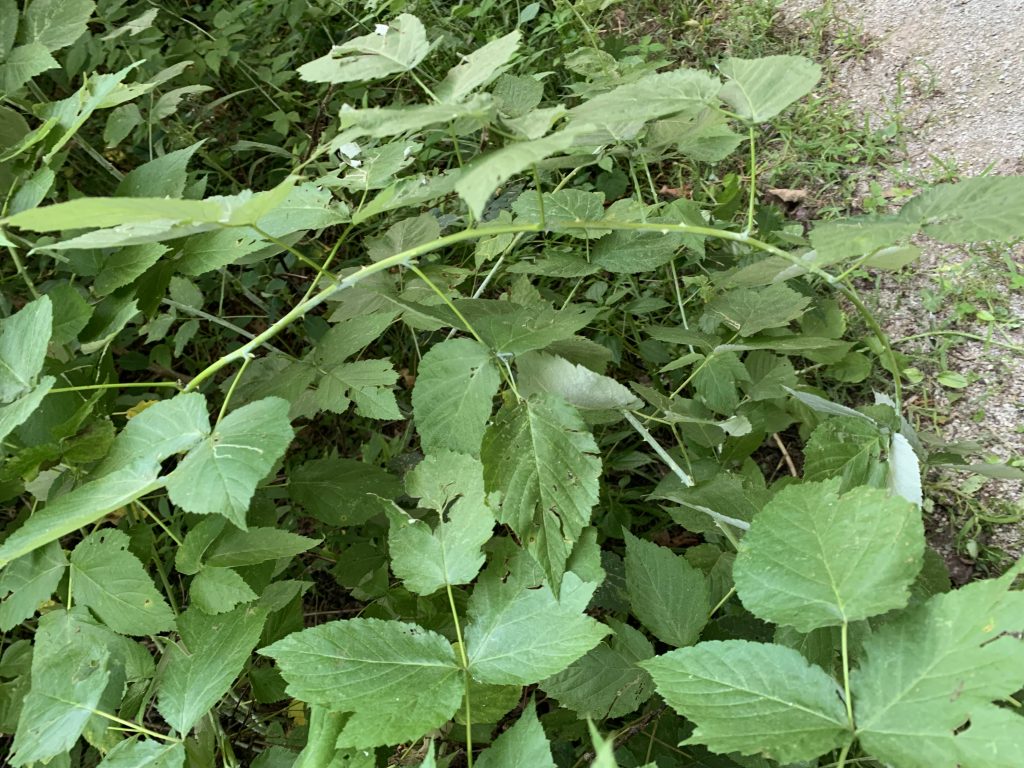
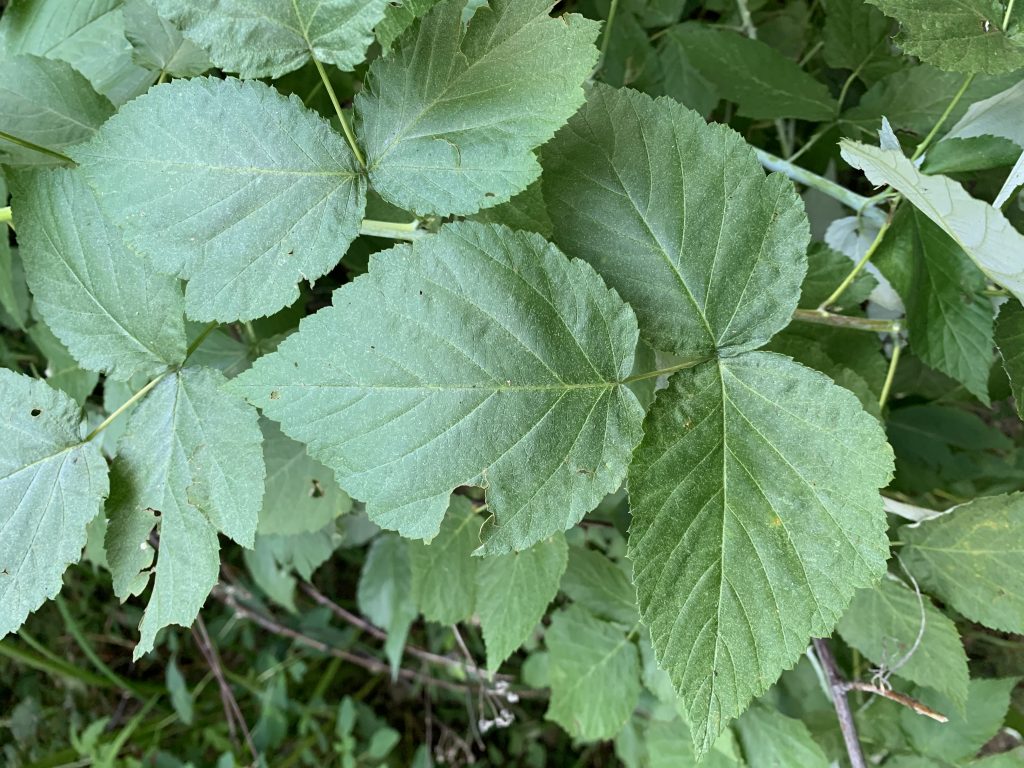
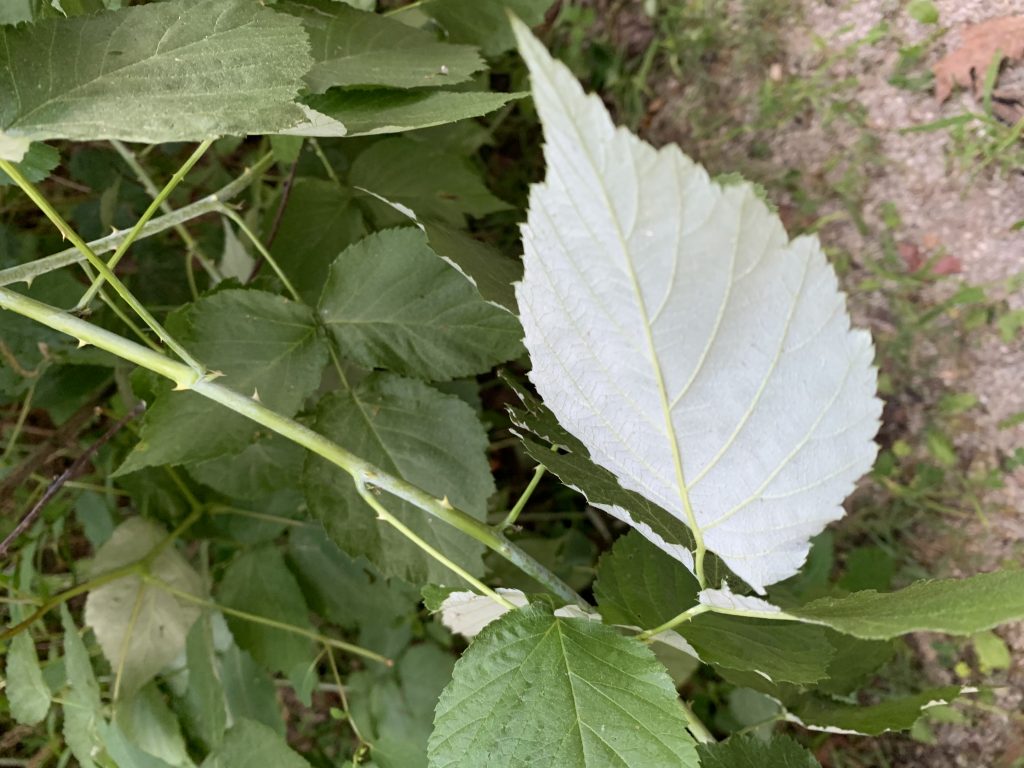
Danger! Avoid!
Poison Ivy, Toxicodendron radicans
When in natural spaces, it’s useful to be able to recognize the ubiquitous species of Poison Ivy. Several handy dandy sayings are useful in its recognition:
“Leaves of three leave them be.” Poison ivy leaves are arranged in groups of three.
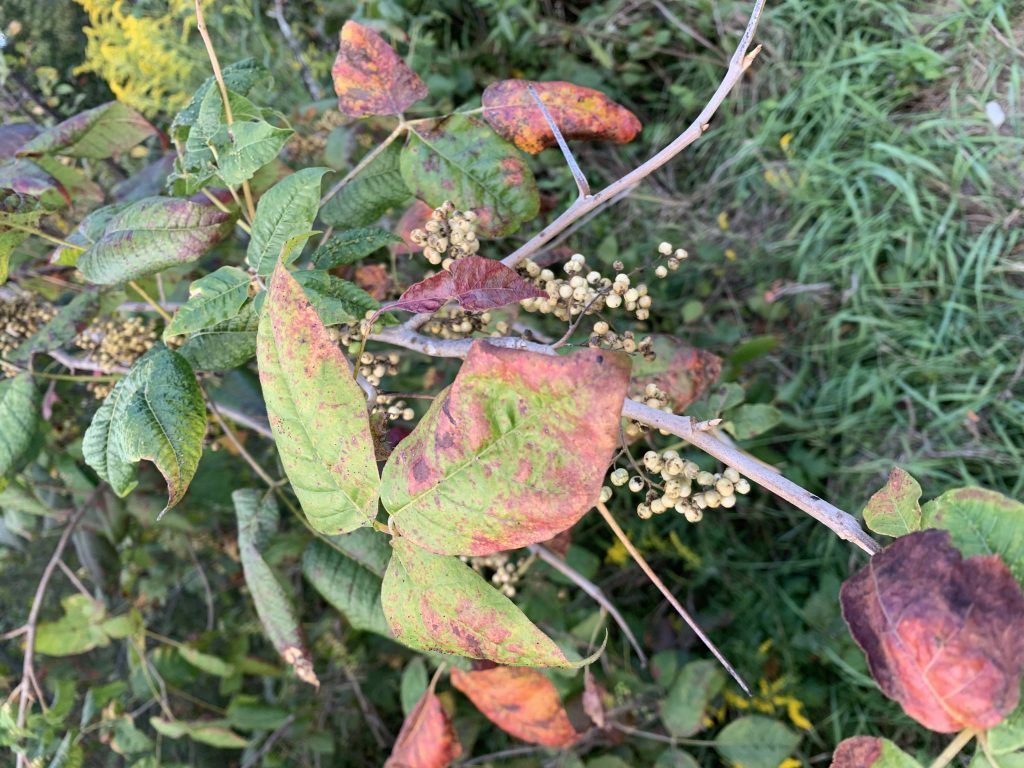
“Hairy vine, no friend of mine.” This cites their aerial roots that grow along the stem and can be a helpful identifying feature.
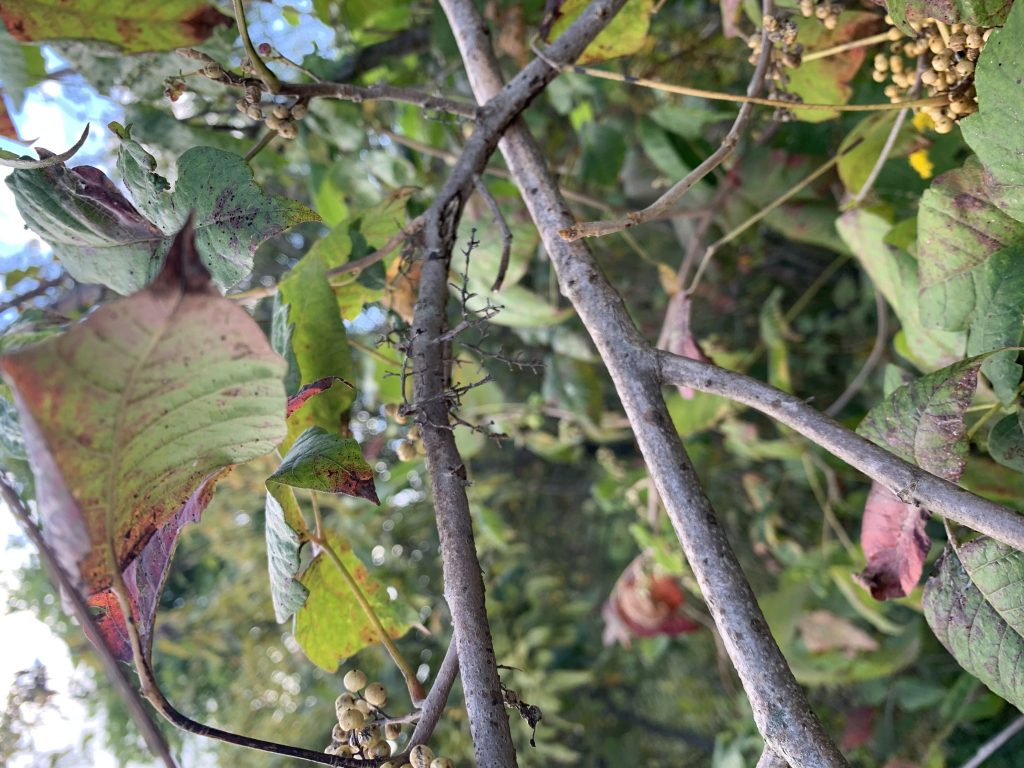
Additionally, they have white fruits pictured here:
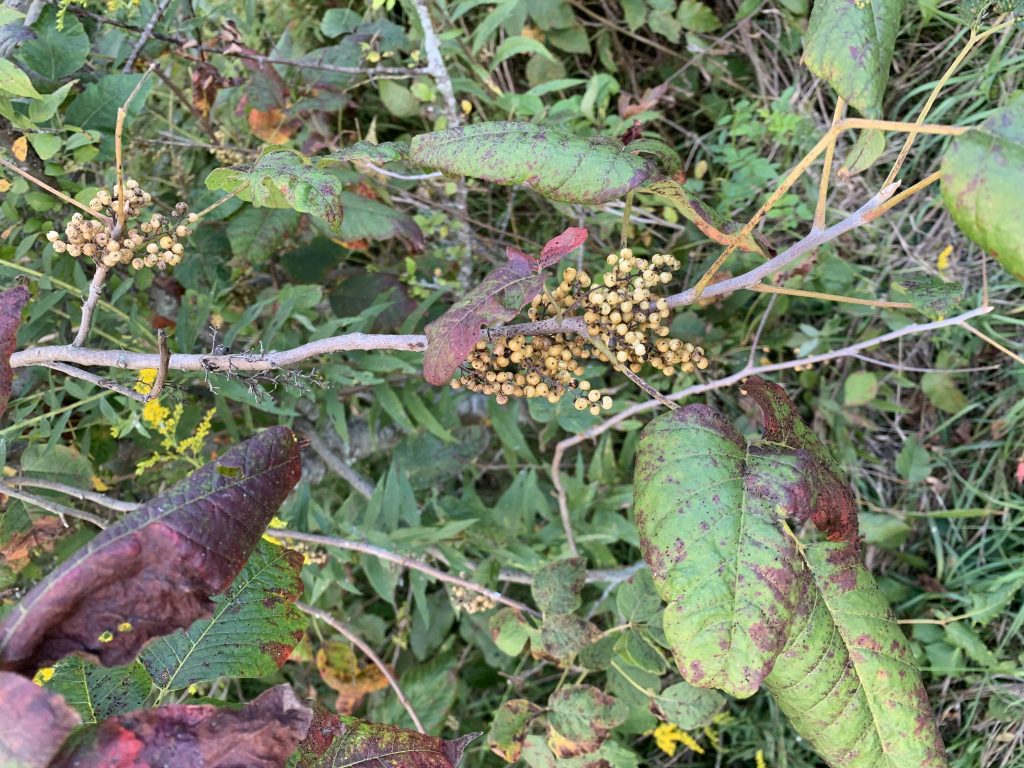
Part 2
(Completed at Sandy Ridge Reservation in Lorain County, OH)
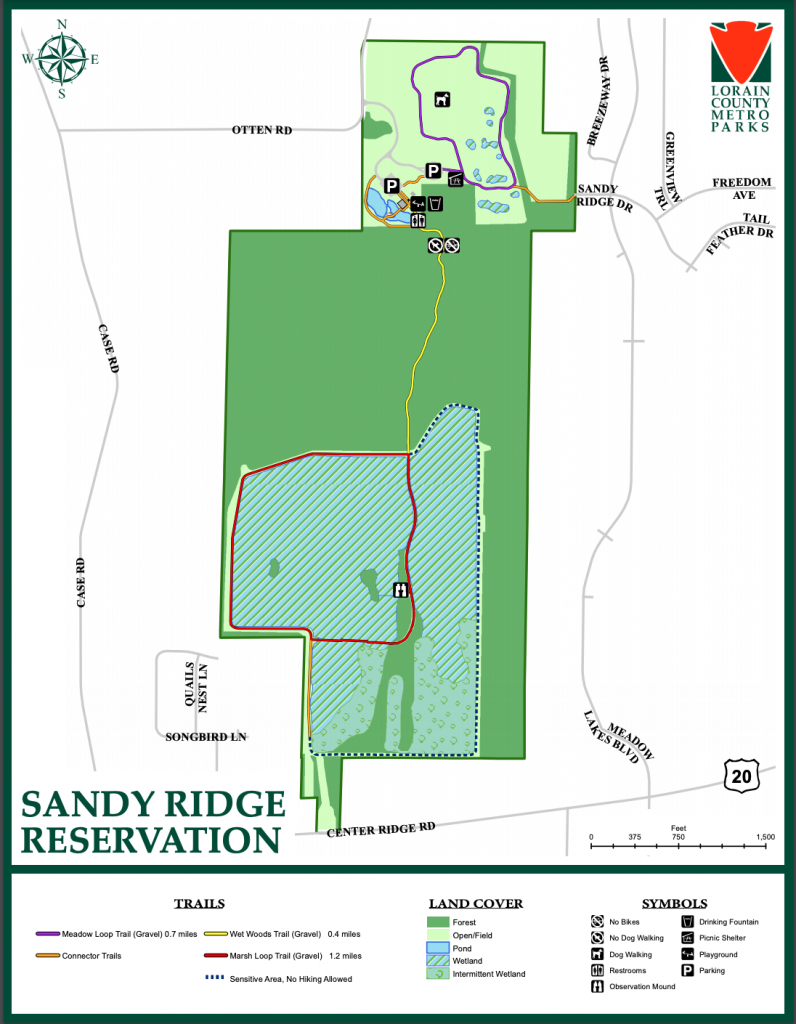
A map of Sandy Ridge Reservation, from the Lorain County Metroparks website.
Due to some personal circumstances and bad timing, I needed to complete the second webpage addition at a different site in Lorain County, Ohio (where I’m from!). Sandy Ridge is a wonderful park for birding and for plant-hunting as I will demonstrate in this post!
As birds go, here’s some of what I saw at Sandy Ridge (even in a spotty rainstorm): Bald Eagles, Sandhill Cranes, Great Blue Herons, Great Egrets, Wood Ducks, Northern Shovelers, Mallards, Belted Kingfisher, Black Capped Chickadees, Killdeer, lots of unidentified sandpipers, two Cooper’s Hawks, another type of hawk I couldn’t ID, lots of swallows, and so much more! On a normal day, you can catch lots of warblers, the occasional Green Heron, a family of Trumpeter Swans, Caspian Terns, American Coots, Osprey oodles of Red-Winged Blackbirds, and a bunch of other awesome species. I saw so many species when I was focusing on plants, it’s even better when you take the time to look for all the birds… I love going there!
Here, I will list species I found at both Sandy Ridge Reservation and Emily Traphagen Park and report their Coefficient of Conservation, or CC. The CC is a number from 1-10 assigned to native flora of a given region and has implications for the type of habitat quality needed by that plant. Low CC values relate to less choosy, more generalist plants that can deal with a wider range of environmental conditions whereas high CC plants require higher quality habitats.
Native Plants from Sandy Ridge:
- Green Ash, Fraxinus pennsylvanica* – 3
- Black Ash, Fraxinus nigra – 7
- Basswood, Tilia americana – 6
- Citronella Horse Balm, Collinsonia canadensis – 5
- Sensitive Fern, Onoclea sensibilis – 2
- Northern Spicebush, Lindera benzoin* – 5
- American Beech, Fagus grandifolia – 7
- Christmas Fern, Polystichum acrostichoides – 3
- Sugar Maple, Acer saccharum – 5
- American Hophornbeam / Ironwood, Ostrya virginiana – 5
- Red Oak, Quercus rubra – 6
- Black Cherry, Prunus serotina – 3
- Tick Seed Beggars / Devil’s Beggar-ticks, Bidens frondosa – 2
- Nodding Beggar-tick, Bidens cernua – 3
- Riverbank Grape, Vitis riparia – 3
- Staghorn Sumac, Rhus typhina – 2
- Pin Oak, Quercus palustris, 5
- Swamp Rose, Rosa palustris – 5
- American Elm, Ulmus americana – 2
- Bur Oak, Quercus macrocarpa – 6
- Common Milkweed, Asclepias syriaca – 1
- Virginia Creeper, Parthenocissus quinquefolia – 2
- Woolgrass, Scirpus cyperinus – 1
- Indiangrass, Sorghastrum nutans – 5
- Big Bluestem – Andropogon gerardi – No CC listed
- Giant Goldenrod, Solidago gigantea – 3
Native Plants from Emily Traphagen:
- Honey Locust, Gleditsia triacanthos – 4
- Prickly Dewberry, Rubus flagellaris – 1
- Black Raspberry, Rubus occidentalis – 1
- Poison Iv-, Toxicodendron radicans – 1
- Spotted Touch-Me-Not, Impatiens capensis – 2
- American Pokeweed, Phytolacca americana – 1
- New England Aster, Aster novae-angliae – 2
- White Snakeroot, Ageratina altissima – No CC listed
Invasive plants from Emily Traphagen:
- Amur Honeysuckle, Lonicera maacki
- Red Clover, Trifolium pratense
- Lesser Burdock, Arctium minu
- American Jumpseed, Persicaria virginiana
Invasive plants from Sandy Ridge
- Queen Anne’s Lace, Daucus carota
- Creeping Thistle, Cirsium arvense
*Documented at both sites
FQAI of Sandy Ridge: 0.9285
FQAI of Emily Traphagen: 0.6667
High CC plants!
All from Sandy Ridge:
Black Ash, Fraxinus nigra – 7
The Black Ash likes to “have its feet wet,” meaning its a species that patrons wetland environments. Additionally, it has intermediate light requirements, meaning it’s not shade tolerant. It requires wetland habitats, open forest (for light access) and has a preference for alkaline soils. Furthermore, the Black Ash us under severe threat by the Emerald Ash Borer. The Black Ash is becoming increasingly rare, giving it a high CC value.

https://www.canada.ca/en/environment-climate-change/services/species-risk-public-registry/cosewic-assessments-status-reports/black-ash-2018.html
American Beech, Fagus grandifolia – 7
Pictured in the next section.
Red Oak, Quercus rubra – 6
Pictured in the next section.
Basswood, Tilia americana – 6
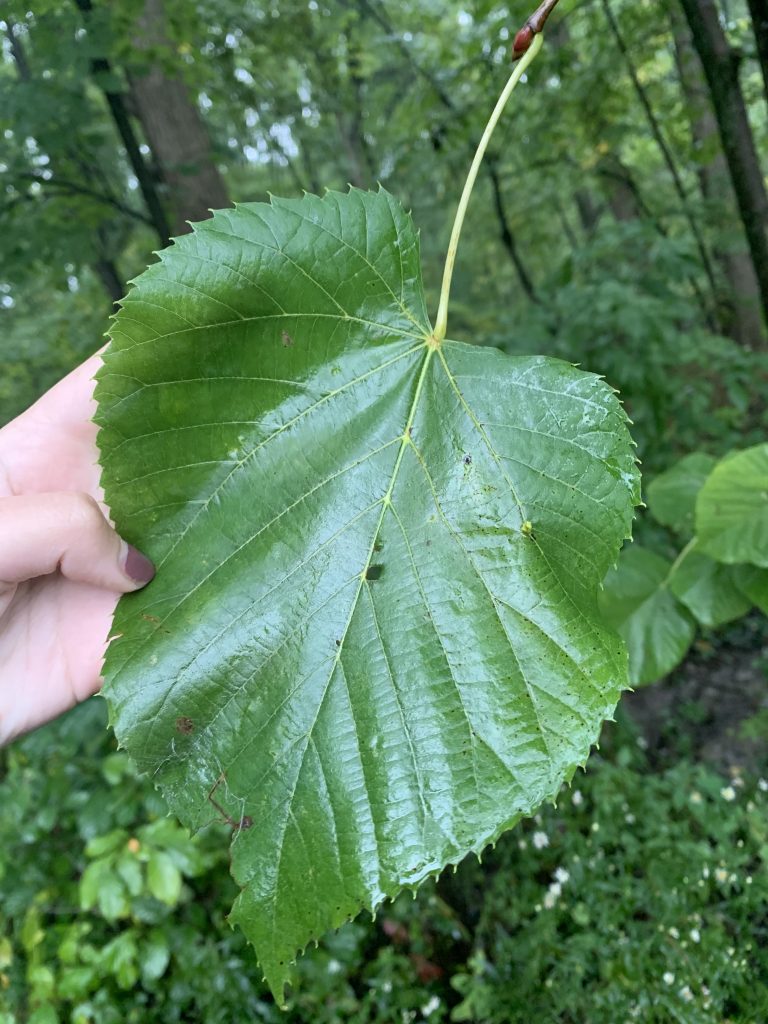
Low CC plants!
From Sandy Ridge:
Common Milkweed, Asclepias syriaca – 1
The Common Milkweed is an abundant, low CC plant. It enjoys full light conditions and propagates by airborne seeds and rhizomatically. It establishes readily and can be found anywhere from fields, prairies, and pastures to fence rows and roadsides.
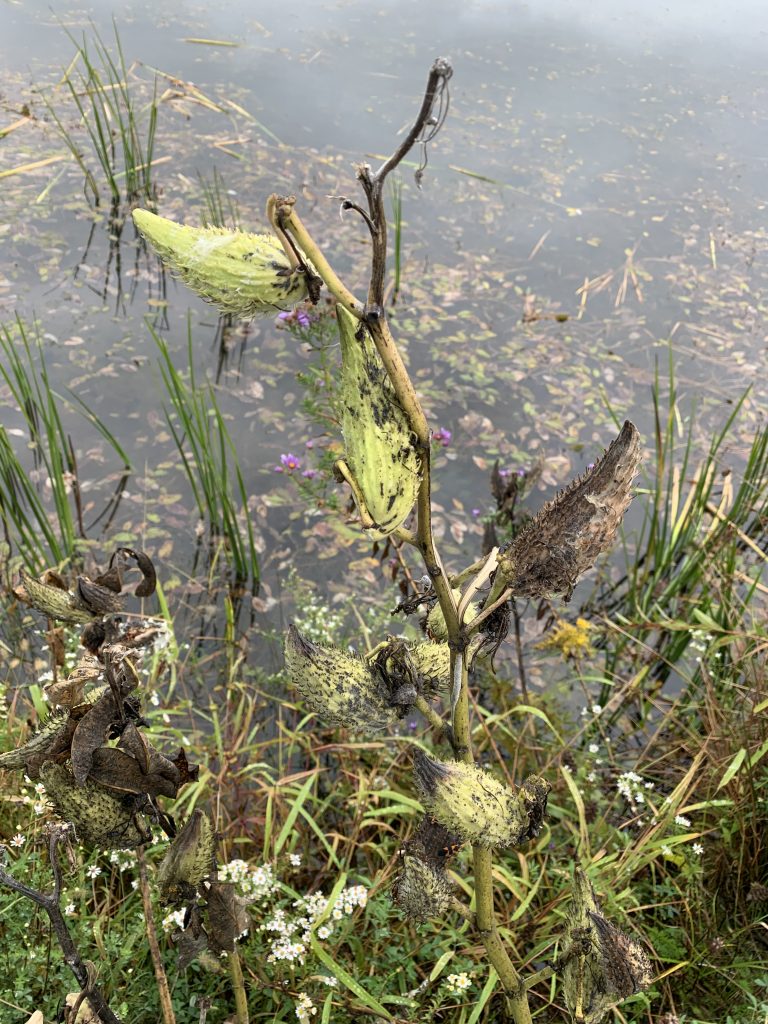
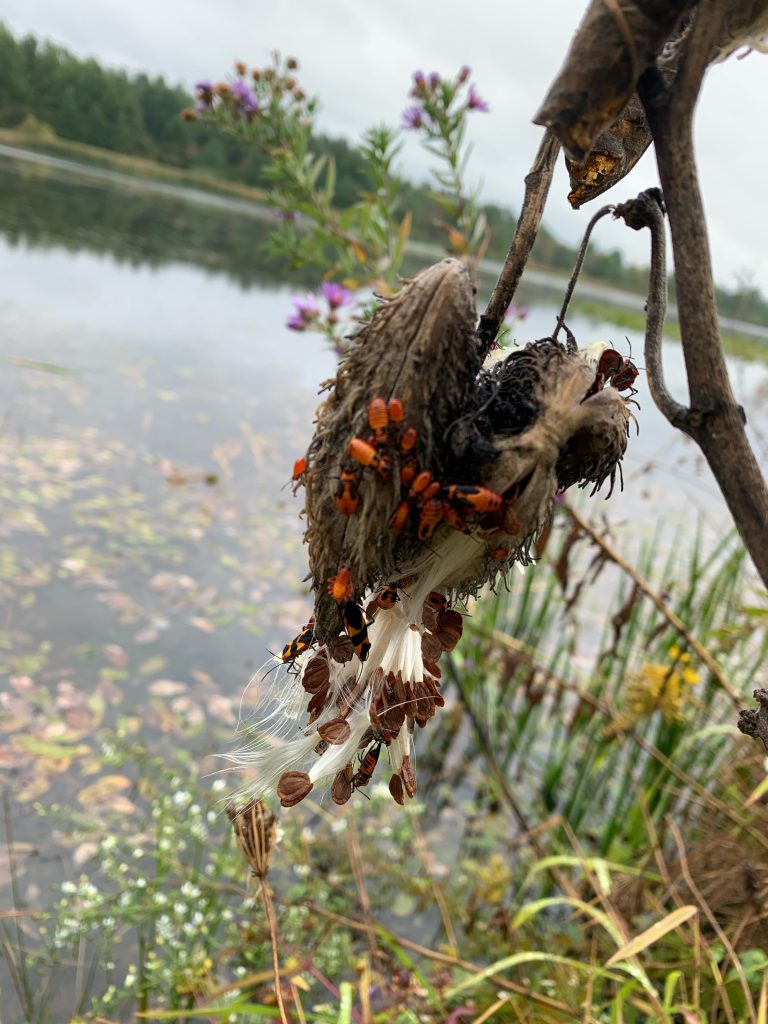
Orange Milkweed bugs on a ripe capsule. Note the seeds starting to come out!
https://www.fs.fed.us/wildflowers/plant-of-the-week/asclepias_syriaca.shtml
American Elm, Ulmus americana – 2
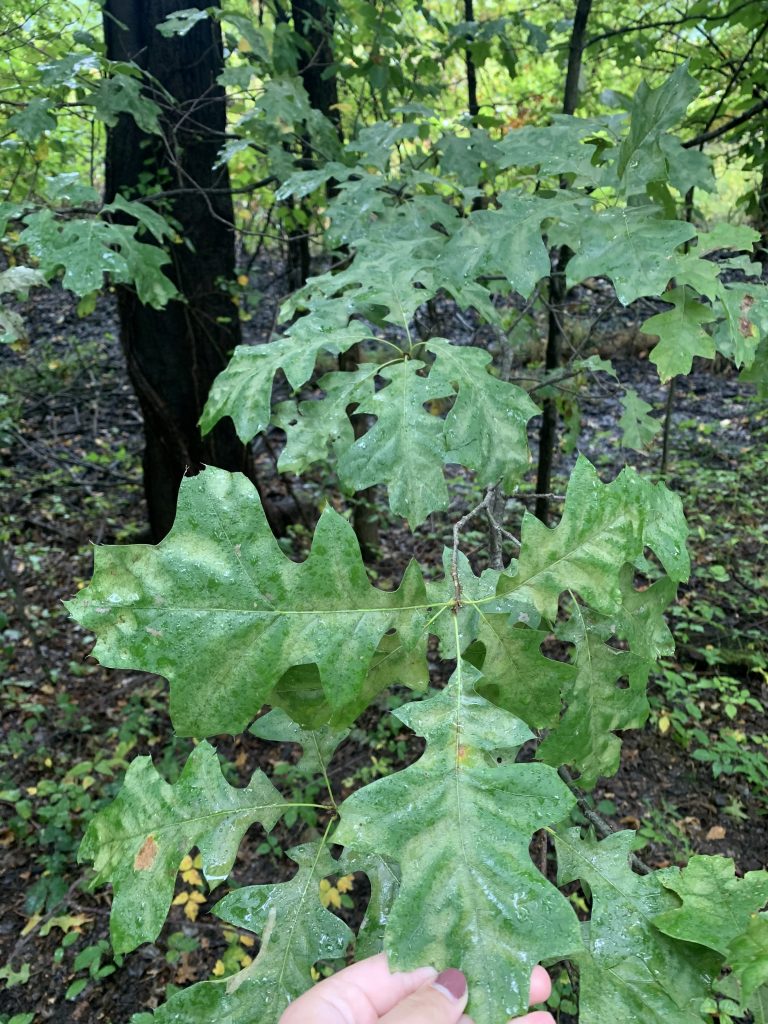
From Emily Traphagen:
Prickly Dewberry, Rubus flagellaris – 1
Pictured in part 1.
Black Raspberry, Rubus occidentalis – 1
Pictured in part 1.
Substrate-Associated Plants
All of these lime-loving trees are from Sandy Ridge Reservation which sits just on the lower edge of the range of the lime-y, clay rich soil of Western Ohio.
Forsythe lists all of these species as being common in high-lime till environments. Each of the following trees is one associated with lime substrates, and I concur based on the location of this park (north of the Glacial Boundary).
Bur Oak, Quercus macrocarpa – 6
The Bur Oak can be identified by its alternate, simple leaves with wavy margins and large lobes near the bottom of the leaf. If the fruits are visible, the acorns are large and distinctive with a warty, fringed cap that gives the tree the name of “Bur.”
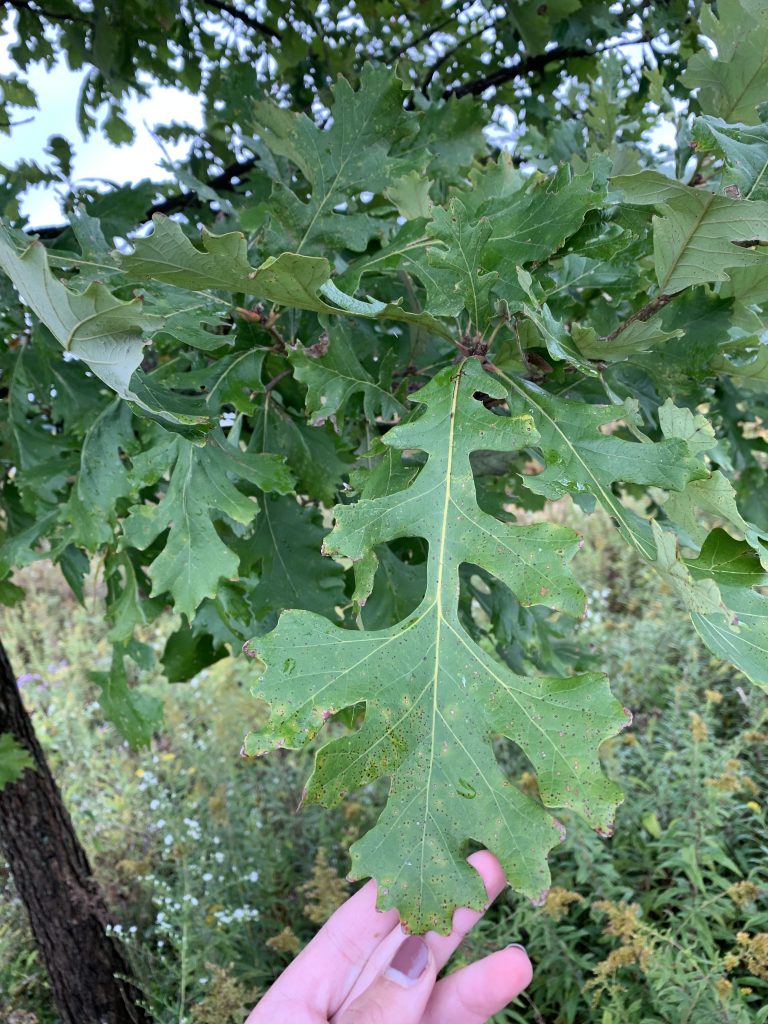
Red Oak, Quercus rubra, 6
The Pin Oak is identified by its alternate, simple leaves with pointed, bristled tips at the tops of lobes.
Pictured above!
American Beech, Fagus grandifolia – 7
The American Beech has alternate, simple oval-shaped leaves with serrated edges and a pointed tip. Paired with the characteristic smooth, grey bark, it’s easy to find!
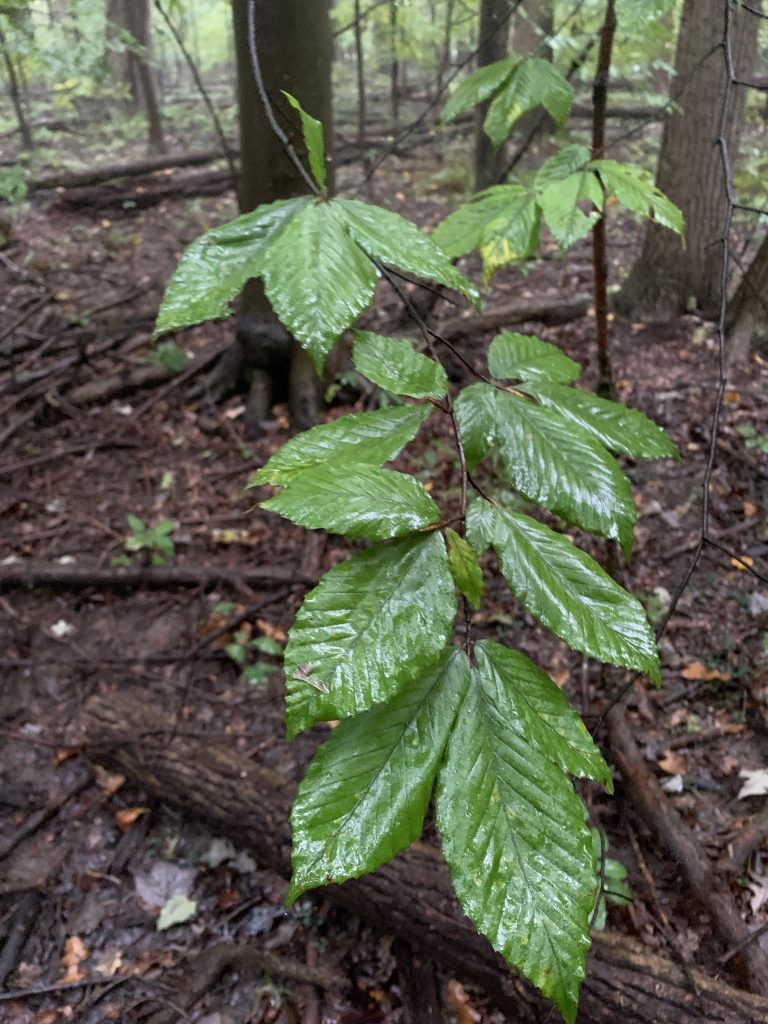
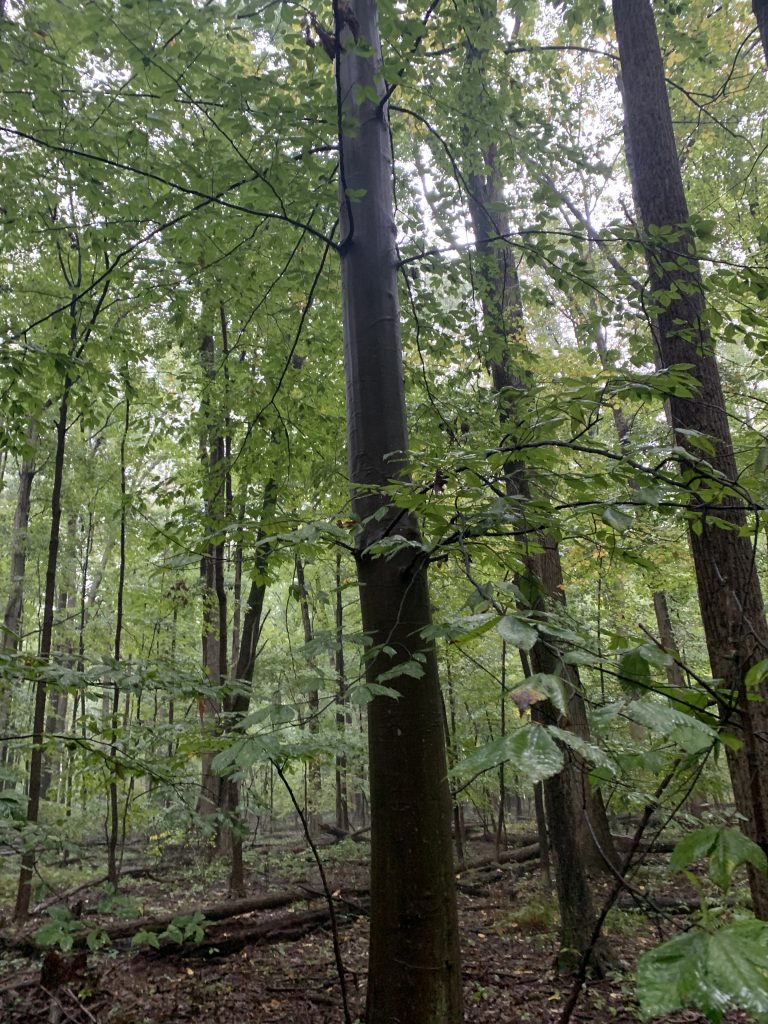
Sugar Maple, Acer saccharum – 5
The Sugar Maple can be identified by its opposite simple leaves. Leaves are palmately lobed with pointed tips. In fruit, this lovely tree makes paired, horseshoe shaped samaras that every kid probably knows as “helicopters.”
Invasives, (Boo, hiss, grrr)
From Sandy Ridge:
Queen Anne’s Lace, Daucus carota
Queen Anne’s Lace is widespread and can be easily identified by its large white umbels (a type of inflorescence that is a flat clump of a bunch of little flowers that looks like an upside-down umbrella!). It can grow 1-4 feet high, and it has pinnate leaves and a hairy stem. Queen Anne’s Lace is also known as Wild Carrot and is edible cooked and raw!

https://altnature.com/gallery/wildcarrot.htm
Creeping Thistle, Cirsium arvense
Creeping thistle has a small, circular purple flower surrounded by bracts. Pictured is just the seedling which has pinnatifid, spiny tipped leaves. This plant is native to Europe. The roots can be used as a tonic, diuretic, toothache remedy, and to treat worms in children.
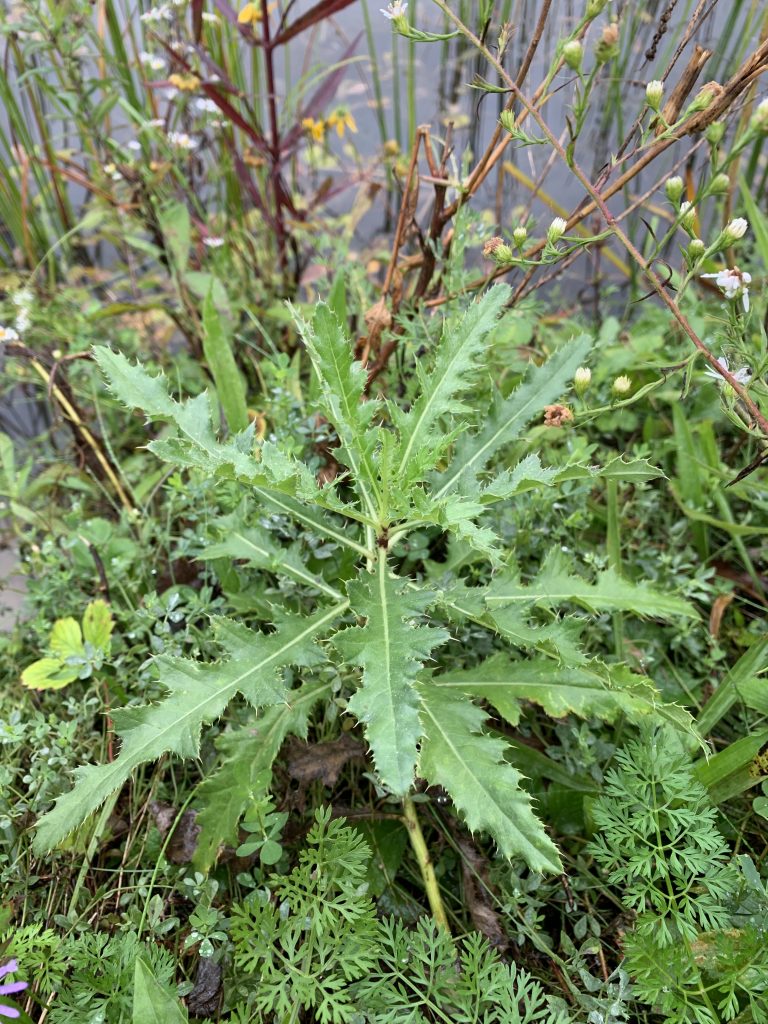
https://pfaf.org/user/plant.aspx?LatinName=Cirsium+arvense
From Emily Traphagen:
Amur Honeysuckle, Lonicera maacki
Like other honeysuckles, the Amur Honeysuckle can be identified by its opposite leaves. Species specific, it has circular red berries.
Amur Honeysuckle is pictured in part 1.
Amur Honeysuckle was initially imported as an ornamental plant in 1898 to the New York Botanical Gardens and was then widely planted for wildlife cover and soil erosion, but it was able to reproduce, disperse, and outcompete native species and is now widespread in the US and can have severe ecological effects, such as ecological traps. For example, honeysuckles are some of the first plants to green up come spring. Usually, Northern Cardinals that are able to nest earlier in the year enjoy a higher reproductive success. However, when honeysuckle is present in the ecosystem, it is the earliest and only green plant in the forest, becoming a beacon for predators as an obvious nest location, which in turn increases predation rates on Cardinals.
https://www.invasive.org/alien/pubs/midatlantic/loma.htm
Red Clover, Trifolium pratense
Red Clover has small, round, spherical flower heads that are a pinkish-purple flowers. The leaves are palmately compound with three ovular leaflets. The leaflets are dark green with a patch of lighter green in the middle. This invasive is native to Europe (surprise, surprise).
Red Clover is pictured in part 1.
Red Clover, however, isn’t the worst of the invasives we have here today. It doesn’t have a huge negative impact on native plants and is able to refresh depleted soil with the nitrogen it stores in its roots.
http://www.bio.brandeis.edu/fieldbio/EFG_DEB_SHU/species%20pages/Red%20Clover/Red%20Clover.html
